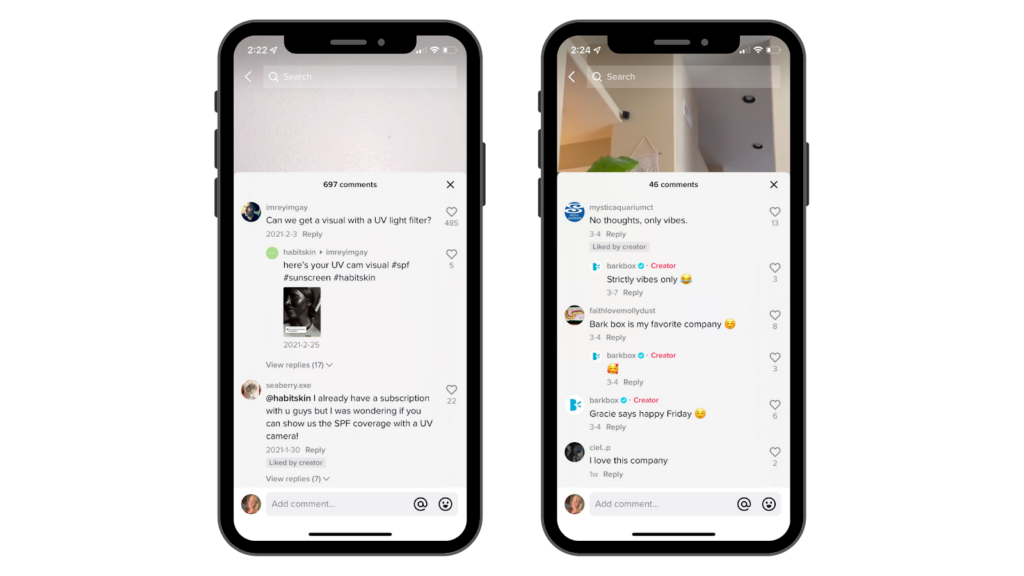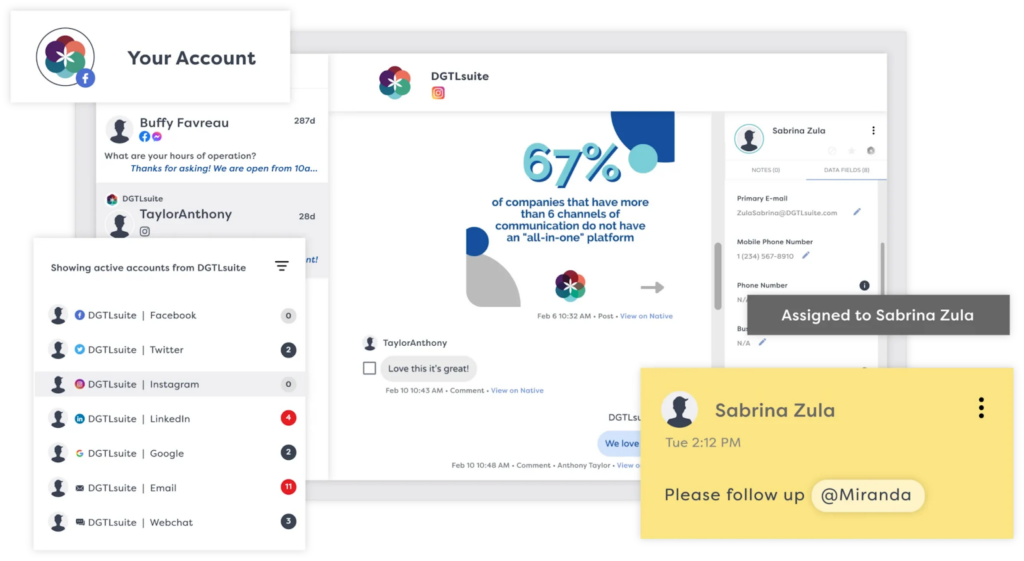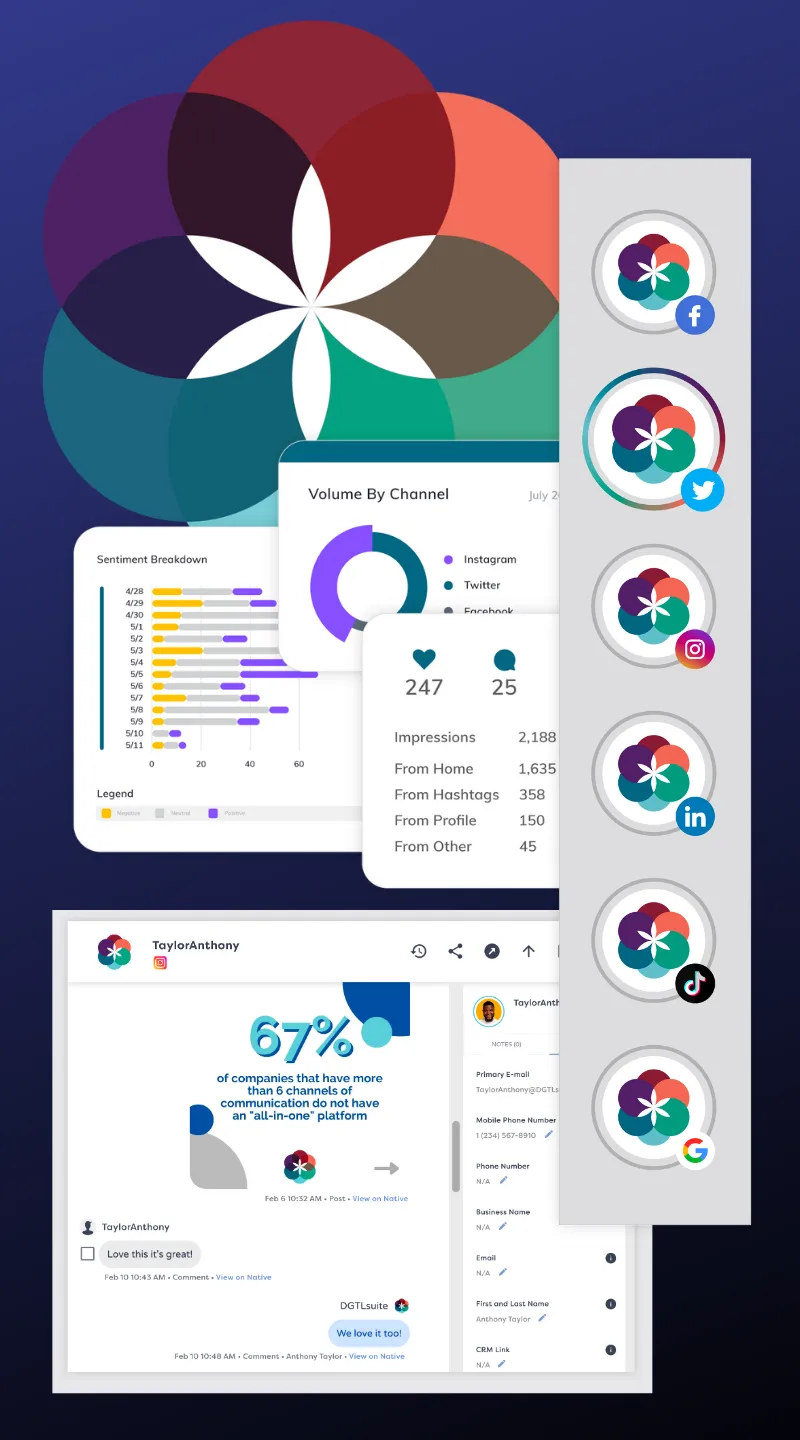Picture this: a customer scrolls through their feed, sees your post, and decides to leave a comment or send you a quick question. How you handle that moment can determine if they stay engaged or look elsewhere.
Digital customer interactions are about more than answering questions—they’re an opportunity to show you’re attentive, approachable, and ready to meet their needs.
Every click, message, or comment is a chance to make a lasting impression. From resolving issues and celebrating loyal customers to managing tricky feedback, the way you interact shapes how people perceive your brand.
So, how can you make sure every digital exchange leaves a positive impression? Let’s break it down into simple, actionable steps that you can start using today.
What Are Digital Customer Interactions?
Digital customer interactions refer to any online exchanges between a business and its customers. These interactions happen across various digital channels, including social media platforms, websites, email, live chat, messaging apps, and even automated tools like chatbots.
Each interaction serves as an opportunity to communicate with customers, address their needs, and shape their perception of your brand. Whether it’s answering a question or engaging with a comment, these moments play a huge role in creating a positive customer experience.
This cannot be any truer for social media. When customers reach out, they’re usually:
- Asking something
- Looking for a solution to a problem
- Trying to find out more about your brand
- Wanting more information about a specific product or service
And when you provide them with what they want, you’re solidifying your brand as trustworthy, worthwhile, and responsive in their minds.
How Do These Interactions Affect Your Social Media Presence?
Your social media is where customers experience your brand firsthand. So, every comment you respond to or message you answer shapes how people see your business.
But how can these digital interactions affect your social media, exactly?
Build Trust That Lasts
When customers see that you’re responsive and helpful, they start to trust you. Whether it’s answering a simple question or solving a big problem, your actions show that you genuinely care about your audience.
Maximize Engagement on Your Digital Channels
Social media loves activity, and so do algorithms. When you engage with your audience—replying to comments, starting conversations, or sharing user-generated content—you’re creating buzz.
That buzz turns into likes, shares, and comments, all of which boost your visibility and help you connect with even more people.
Show Off Your Brand Personality
Every response is an opportunity to highlight what makes your brand unique. Whether you’re witty, warm, or straight to the point, interactions give you a chance to let your personality shine. Just take a look at some brands replying to TikToks, even if the videos are not their own.
 Image: Chatdesk.com
Image: Chatdesk.com
People don’t just buy stuff, they connect with brands that actually feel human. And who knows? Maybe a witty tweet or TikTok comment can make your business go viral.
Tackle Negative Feedback the Right Way
Negative reviews or complaints might feel like a headache, but they’re also an opportunity. By addressing issues publicly and professionally, you show potential customers that you’re committed to making things right.
Nobody expects perfection, but they do appreciate accountability.
Turn Followers Into Fans
A thoughtful reply can go a long way in creating loyalty. Customers who feel valued are more likely to stick around and even recommend your business to others. Over time, these small moments of connection add up, turning casual followers into lifelong fans.
Win the Algorithm Game
Platforms like Instagram, Facebook, and X (Twitter) prioritize accounts that stay active and engage with their audience.
Regular interactions—be it through DMs, comments, or post replies—signal to algorithms that your account is worth showing to more people.
Spark Word-of-Mouth Marketing
When customers enjoy interacting with your brand on social media, they’re more inclined to tell their friends and family about it.
Whether it’s a screenshot of a funny reply or a story about great customer service, these organic shares can bring in new followers and customers.
How to Make The Most of Each Customer Interaction
Every interaction, no matter how small, can strengthen the bond between you and your audience. That said, how can you make every one count?
1. Respond Quickly
Speed matters—big time. Customers don’t want to feel ignored, and slow responses can make them lose confidence in your business. Almost half of all customers (46%) expect businesses to respond in less than 4 hours, with 12% saying they expect a response within 15 minutes or less.
It gets even more serious when customers need help. A staggering 90% view an instant response as either crucial or very important. For most, “instant” means within 10 minutes or faster.
Meeting these expectations shows that you value your customers’ time and are dedicated to providing exceptional service. Prioritize speed in your replies, whether it’s a social media comment, live chat, or email.
2. Provide Personalized Experiences
Nobody wants to feel like just another face in the crowd. Personalization shows your customers that you see them as individuals, not just transaction numbers. It’s the little things that make a big impact and keep people coming back.
Here’s how you can make your interactions feel more personal:
- Call them by name
- Mention past chats or purchases
- Offer tailored suggestions
- Chat with them on the platform they prefer, whether it’s social media, email, or live chat.
- Mirror their tone
A little personalization can turn a simple interaction into a memorable one!
3. Build an Omnichannel Support System
Customers interact with your business in different ways—social media, email, live chat, phone, and more. An omnichannel support system ties all these channels together to create a seamless experience no matter where the conversation starts or ends.
Imagine this: A customer messages you on Instagram, follows up via email, and then calls your support team. With an omnichannel system, your team has all the context so the customer doesn’t have to repeat themselves.
This smooth handoff reduces customer effort, avoids frustration, and increases customer satisfaction. Plus, it can also help your team resolve issues faster.
To build this kind of system, invest in tools that integrate all your communication channels into one dashboard, like DGTLsuite’s unified inbox. This approach not only simplifies things for your team but also makes sure your customers always have a positive experience, no matter how they choose to connect with you.

4. Offer Self-Service Options
Sometimes, customers prefer solving problems on their own. Self-service options, like FAQs, knowledge bases, or tutorial videos, empower them to find answers without waiting for support. This approach saves time for both your team and your customers.
Here’s what to include:
- FAQs: Address common questions in a clear and easy-to-navigate format.
- How-to guides: Provide step-by-step instructions for troubleshooting or using your products.
- Video tutorials: Short, visual walkthroughs can be more effective than written content.
Self-service doesn’t replace human support but complements it. By making helpful resources readily available, you reduce frustration and show your commitment to solving customer needs efficiently.
5. Deploy Automated Customer Service Tools
Automated tools like chatbots and AI assistants are a smart way to keep your customers happy and your team focused. They’re great for handling routine customer inquiries—think order tracking, store hours, or return policies—without making customers wait.
Plus, they’re available 24/7, so your audience gets help whenever they need it, even after business hours.
These tools don’t just save time; they make life easier for everyone. Your team can spend more energy on solving complex issues while the bots take care of the basics. Automation also ensures consistency, so customers get the same accurate answers no matter when or where they ask.
Of course, automation works best when paired with real support. Always give customers the option to reach a live agent if they need extra help. It’s the perfect balance of speed and human connection.
6. Consider Accepting Phone Calls
Even in an advanced digital world, phone calls can still make a big difference, especially for certain businesses.
Industries like healthcare, financial services, and tech support often handle complex or sensitive issues that are easier to address over the phone. Sometimes, hearing a real person’s voice provides the clarity and reassurance customers need.
Businesses offering personal services, like consultants, local repair companies, or boutique shops, can benefit even more. A quick phone conversation can make your brand feel approachable and show customers you’re there for them.
While digital customer service channels are important, having a phone line as an option sets you apart. It adds a personal touch, makes customers feel valued, and helps you build stronger relationships.
7. Monitor and Respond to Social Mentions
Not every customer tags your brand when they talk about you online, but that doesn’t mean you should miss out. Keeping an eye on untagged mentions is a smart way to show your audience you’re listening and care about what they’re saying.
Imagine a customer raves about your product in a tweet without tagging you. Jumping in with a quick thank-you can make their day. On the other hand, if someone has a complaint, a proactive response shows you’re paying attention and ready to help.
Social listening tools can make this easier by tracking mentions of your brand name or related keywords. This way, you can join conversations without spending hours scrolling through posts.
8. Handle Negative Feedback With Grace
Negative feedback isn’t the end of the world—it’s an opportunity to show your professionalism and build trust. How you respond can turn a dissatisfied customer into a loyal advocate.
Start by acknowledging the issue. A simple “We’re sorry this happened” can go a long way in calming an upset customer.
Avoid being defensive, even if the feedback feels unfair. Instead, focus on understanding their perspective. Once you’ve identified the problem, offer a solution. Whether it’s a replacement, a refund, or a personal follow-up, showing you’re willing to fix things makes a big difference.
Keep your tone polite and empathetic, and if possible, take the conversation to a private channel like direct messages or email. This keeps the focus on resolution and prevents public misunderstandings.
Responding quickly is also key. Delayed replies can escalate frustration and make customers feel ignored.
Finally, treat every piece of feedback as a learning experience. Negative comments can reveal gaps in your product or service, giving you a chance to improve. Handling criticism with grace not only wins back unhappy customers but also shows others that your business values transparency and accountability.
9. Offer Surprises From Time to Time
Everyone loves a good surprise, and offering unexpected perks can leave a lasting impression on your customers. These little gestures show you value them and make your brand more memorable.
Here are some ways to delight your audience:
- Exclusive discounts
- Free upgrades
- Random giveaways
- Handwritten notes
- Early access
Surprises don’t have to be expensive, they just need to feel thoughtful. These small efforts can go a long way in building customer loyalty and creating buzz around your brand.
Offer Superb Customer Care With DGTLsuite
Every digital interaction is a chance to show your audience that your brand isn’t just another business—it’s one that listens, understands, and values its customers. Each message, reply, or solution can either strengthen customer loyalty or push people away.
Still, keeping up with the fast-paced world of digital communication can feel overwhelming. How can you create experiences that capture people’s attention (and, hopefully, hearts) without stretching yourself too thinly?

DGTLsuite takes the stress out of customer care by giving you the tools to manage conversations, craft meaningful connections, and measure your team’s performance—all in one place:
- Unified inbox: Manage conversations from multiple communication channels in one place for a seamless workflow.
- Social media management: Schedule, publish, and monitor content to engage your audience effectively.
- Customer support tools: Quickly respond to inquiries with contextual conversation views and notes.
- Analytics dashboard: Track response times, engagement metrics, and team performance to improve service.
- Automation capabilities: Streamline repetitive tasks like sorting conversations or responding to common customer queries.
- Personalized responses: Access previous interactions and customer data to tailor responses for each customer.
Ready to raise the bar on customer care? Book a discovery call today!
FAQs About Digital Customer Interactions
What is a digital customer relationship?
A digital customer relationship refers to the connection between a business and its customers built through online interactions. This includes communication on social media, emails, live chat, or any other digital platform. It’s about creating trust and loyalty by being responsive and offering meaningful experiences in the digital space.
What is an example of digital customer service?
An example of digital customer service is a company using live chat on its website to answer customer questions in real time. Another common example is responding to comments or direct messages on social media platforms to resolve issues or provide product information.
What are the 5 stages of the digital customer journey?
The five stages of the digital customer journey are:
- Awareness: Customers discover your brand through ads, social media, mobile apps, or search engines.
- Consideration: They explore your products or services and compare options.
- Purchase: They decide to buy and complete the transaction.
- Retention: You keep them engaged with personalized content, offers, and a positive digital service.
- Advocacy: Satisfied customers recommend your brand to others, becoming loyal advocates.
Understanding these stages helps businesses undergo digital transformation much more easily.
Why should a business offer digital customer service?
Businesses should offer digital customer service to meet the expectations of today’s online-savvy customers. It allows companies to provide customer support quickly across channels like social media, live chat, and email.






